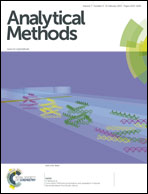Magnetic solid-phase extraction based on Fe3O4@polyaniline particles followed by ultrafast liquid chromatography for determination of Sudan dyes in environmental water samples
Abstract
Magnetic Fe3O4@polyaniline (Fe3O4@PANI) particles were successfully prepared and used as an adsorbent in the magnetic solid-phase extraction of Sudan dyes in environmental water samples. The Fe3O4@PANI particles adsorbed analytes were isolated from the sample matrix using an external magnetic field. The analytes were separated and determined by ultrafast liquid chromatography. Significant influential factors, including amount of Fe3O4@PANI particles, pH value, ion strength, extraction time, type of desorption solvent, volume of desorption solvent, desorption time and sample volume, were optimized. Satisfactory extraction recoveries were obtained with only 8 mg of Fe3O4@PANI particles. In addition, the Fe3O4@PANI particles can be reused after a facile washing process. The limits of detection for Sudan I, II, III and IV were 0.041, 0.080, 0.147 and 0.151 ng mL−1, respectively. The intra-day and inter-day precisions with relative standard deviations were 1.3–5.4% and 2.6–7.3%, respectively. Recoveries obtained by analyzing spiked environmental water samples were between 92.4% and 106.9%.


 Please wait while we load your content...
Please wait while we load your content...